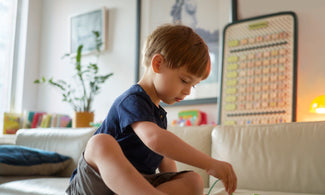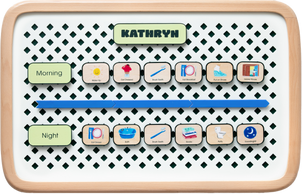Using The Springboard to Build Independence

Feeling your patience run thin because most mornings are madness? Tired of repeating yourself over and over (and over) again? Find yourself constantly saying things like “hurry up” or “we’re going to be late”? The Springboard helps children visualize their routines, which boosts confidence, encourages independence and makes the day feel a little smoother for everyone.
Here are 5 ways you can support independence with a Springboard:
Practice Previewing
In order for children to be able to take risks and try new things they have to feel secure. Use the Springboard to give your child the comfort of knowing what is going to happen in their day so that they feel safe enough to develop independence. As your child gets to know their Springboard, help them to make sense of their days and routines by previewing.
In the morning, invite your child to look at their Springboard with you. Say,
“Let’s look at your Springboard. You just woke up, can you point to your Wake Up tile? Let’s look at what is going to happen for the rest of the day.”
Take time to walk through each tile and answer any questions that come up. Remind your child that they can check their Springboard anytime they have questions about their routine.
Give Choices
Empower your child to take ownership of his or her day from the moment you set up the Springboard together. When you’re setting up your board, identify moments in the day where your child can choose what happens in the routine.
We’re going to build your bedtime routine now. Would you like to put on pajamas or brush teeth first?
Children crave independence and choices give them a sense of control. Choices are also a great strategy if you notice that there’s a specific task in the routine, such as getting dressed, that your child seems unable or unwilling to complete. Offering choice can help children shift gears if they are feeling rushed or frustrated.
“It’s time to get dressed and go outside. You can wear your sandals or your sneakers. Which pair do you choose?”
Be Concrete
You may find that your child has become dependent on you as a timekeeper. Get in the habit of inviting your child to answer their questions about the day with their Springboard.
You’re wondering what is going to happen after breakfast. Why don’t you take a look at your Springboard and see what comes next.
Over time, children will get in the habit of checking the board, instead of asking you. This shift is incredibly empowering because it offers new visibility into the day and gives children the opportunity to problem solve independently.
Offer Playful Practice
Your Springboard tiles are a great tool for breaking down daily routines into manageable components for your little one. Having the day broken down will also help you to identify points of ease and moments of challenge throughout the day.
If you notice that there’s a particular tile that is a struggle every day, encourage your child to practice the challenging task in a stress-free setting. For example, if your child is having trouble getting dressed independently or putting on his or her shoes every morning, have some playful evening practice sessions.
Explain,
“It takes a lot of practice to get used to new shoes! I bet some ‘shoe practice’ will help you feel more comfortable.” Rather than counting how many times your child completes a specific task, dedicate a certain amount of time to practicing.
This takes some pressure off.
“What song should we listen to during our shoe practice?”
Be Specific
The concept of time is abstract and waiting is hard. This is especially true if/when children are told we’ll join them “in a little while” or “later on” and they feel like they’ve been waiting a long time.
If your child is craving your attention and it's time for them to be independent, use the Springboard to show them when they will have time with you or when it will be a Family Time. You might say something like,
“It seems like you really want to go outside together. You can see that right now it’s Quiet Time and next comes Playground. I’m going to work on my computer until Quiet Time is over and we will go outside right after. Would you like to draw on your own for now or finish your beading?”
Once it’s time to transition, make sure to follow through!
